change wheel JEEP COMPASS 2011 1.G User Guide
[x] Cancel search | Manufacturer: JEEP, Model Year: 2011, Model line: COMPASS, Model: JEEP COMPASS 2011 1.GPages: 80, PDF Size: 3.09 MB
Page 35 of 80
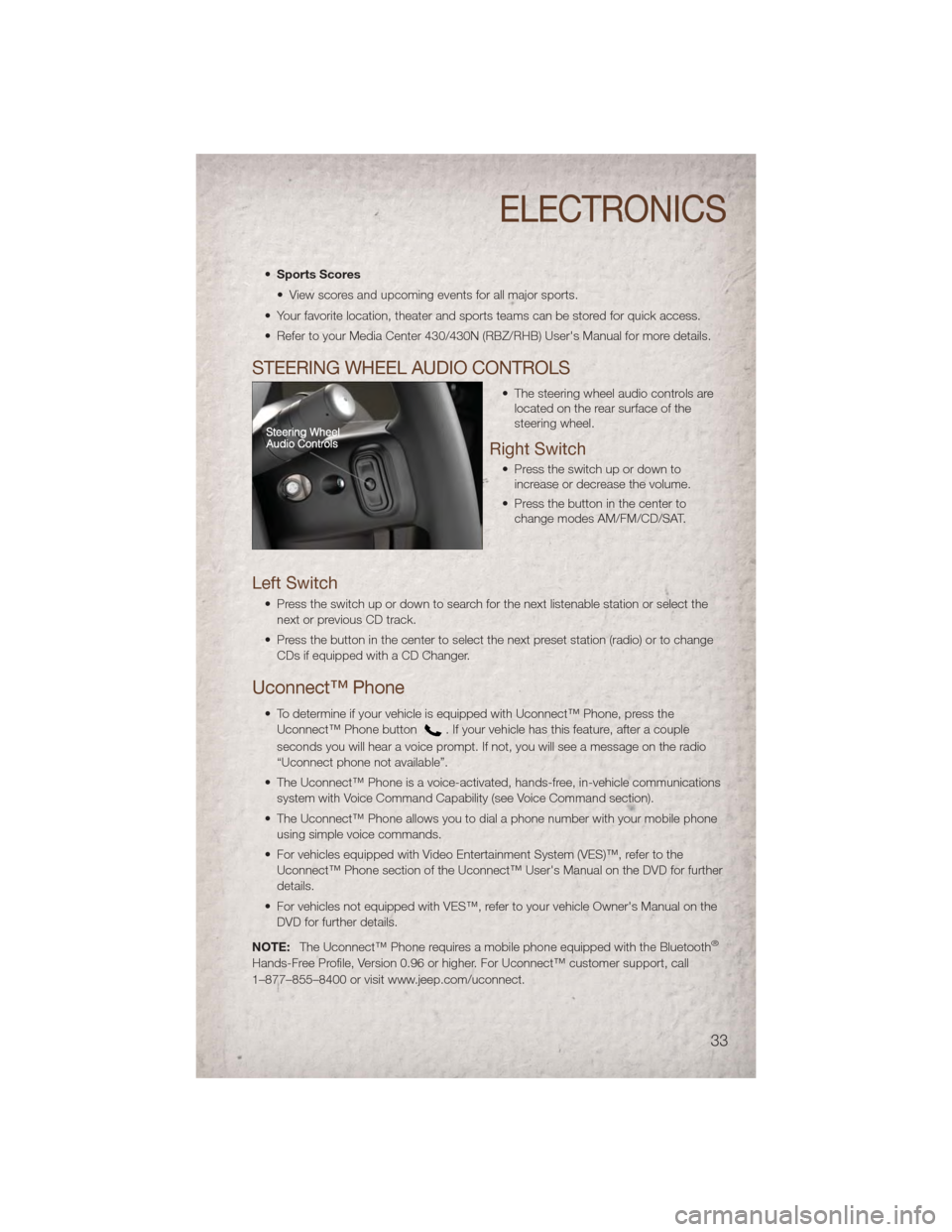
•Sports Scores
• View scores and upcoming events for all major sports.
• Your favorite location, theater and sports teams can be stored for quick access.
• Refer to your Media Center 430/430N (RBZ/RHB) User's Manual for more details.
STEERING WHEEL AUDIO CONTROLS
• The steering wheel audio controls are located on the rear surface of the
steering wheel.
Right Switch
• Press the switch up or down toincrease or decrease the volume.
• Press the button in the center to change modes AM/FM/CD/SAT.
Left Switch
• Press the switch up or down to search for the next listenable station or select the
next or previous CD track.
• Press the button in the center to select the next preset station (radio) or to change CDs if equipped with a CD Changer.
Uconnect™ Phone
• To determine if your vehicle is equipped with Uconnect™ Phone, press theUconnect™ Phone button
. If your vehicle has this feature, after a couple
seconds you will hear a voice prompt. If not, you will see a message on the radio
“Uconnect phone not available”.
• The Uconnect™ Phone is a voice-activated, hands-free, in-vehicle communications system with Voice Command Capability (see Voice Command section).
• The Uconnect™ Phone allows you to dial a phone number with your mobile phone using simple voice commands.
• For vehicles equipped with Video Entertainment System (VES)™, refer to the Uconnect™ Phone section of the Uconnect™ User's Manual on the DVD for further
details.
• For vehicles not equipped with VES™, refer to your vehicle Owner's Manual on the DVD for further details.
NOTE: The Uconnect™ Phone requires a mobile phone equipped with the Bluetooth
®
Hands-Free Profile, Version 0.96 or higher. For Uconnect™ customer support, call
1–877–855–8400 or visit www.jeep.com/uconnect.
ELECTRONICS
33
Page 39 of 80
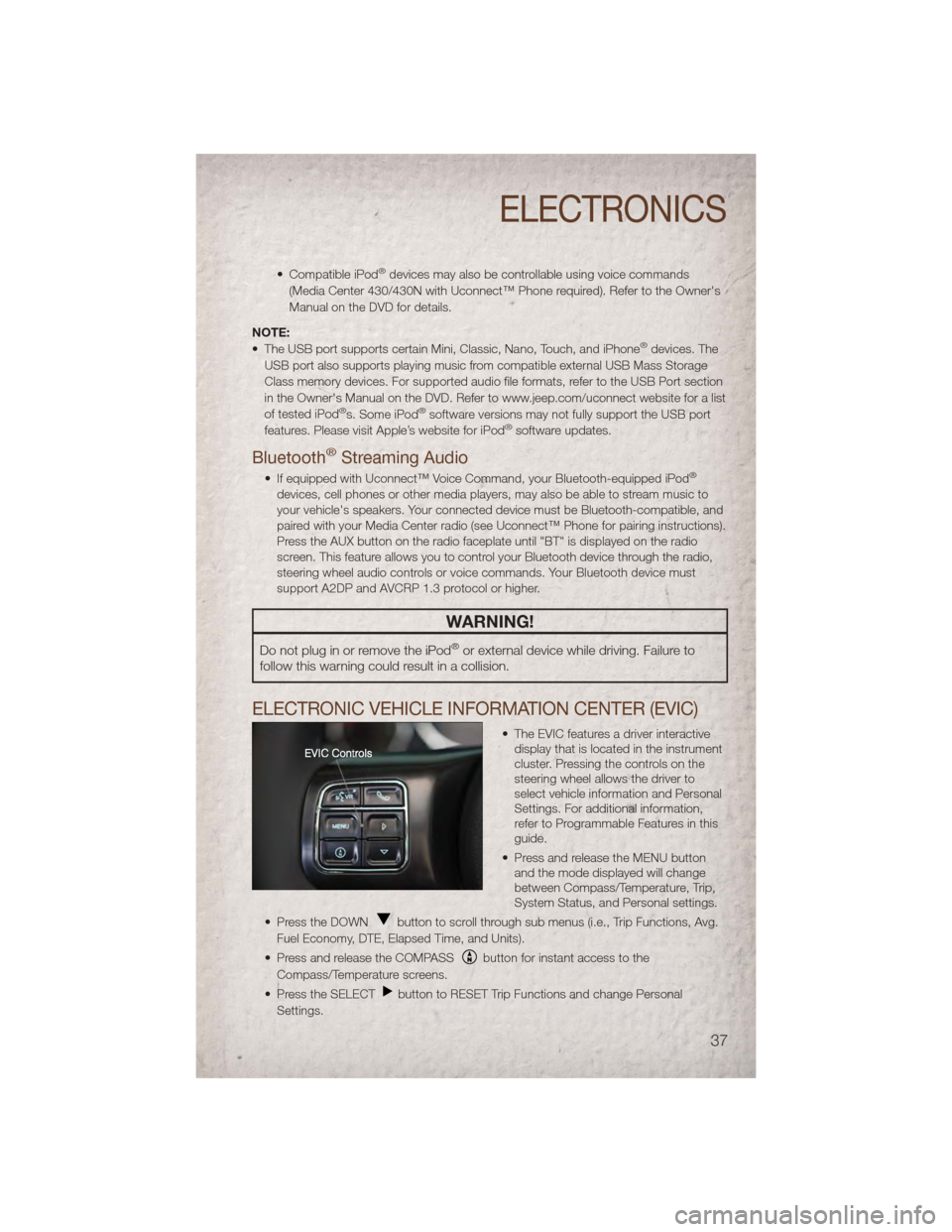
• Compatible iPod®devices may also be controllable using voice commands
(Media Center 430/430N with Uconnect™ Phone required). Refer to the Owner's
Manual on the DVD for details.
NOTE:
• The USB port supports certain Mini, Classic, Nano, Touch, and iPhone
®devices. The
USB port also supports playing music from compatible external USB Mass Storage
Class memory devices. For supported audio file formats, refer to the USB Port section
in the Owner's Manual on the DVD. Refer to www.jeep.com/uconnect website for a list
of tested iPod
®s. Some iPod®software versions may not fully support the USB port
features. Please visit Apple’s website for iPod®software updates.
Bluetooth®Streaming Audio
• If equipped with Uconnect™ Voice Command, your Bluetooth-equipped iPod®
devices, cell phones or other media players, may also be able to stream music to
your vehicle's speakers. Your connected device must be Bluetooth-compatible, and
paired with your Media Center radio (see Uconnect™ Phone for pairing instructions).
Press the AUX button on the radio faceplate until "BT" is displayed on the radio
screen. This feature allows you to control your Bluetooth device through the radio,
steering wheel audio controls or voice commands. Your Bluetooth device must
support A2DP and AVCRP 1.3 protocol or higher.
WARNING!
Do not plug in or remove the iPod®or external device while driving. Failure to
follow this warning could result in a collision.
ELECTRONIC VEHICLE INFORMATION CENTER (EVIC)
• The EVIC features a driver interactive display that is located in the instrument
cluster. Pressing the controls on the
steering wheel allows the driver to
select vehicle information and Personal
Settings. For additional information,
refer to Programmable Features in this
guide.
• Press and release the MENU button and the mode displayed will change
between Compass/Temperature, Trip,
System Status, and Personal settings.
• Press the DOWN
button to scroll through sub menus (i.e., Trip Functions, Avg.
Fuel Economy, DTE, Elapsed Time, and Units).
• Press and release the COMPASS
button for instant access to the
Compass/Temperature screens.
• Press the SELECT
button to RESET Trip Functions and change Personal
Settings.
ELECTRONICS
37
Page 48 of 80
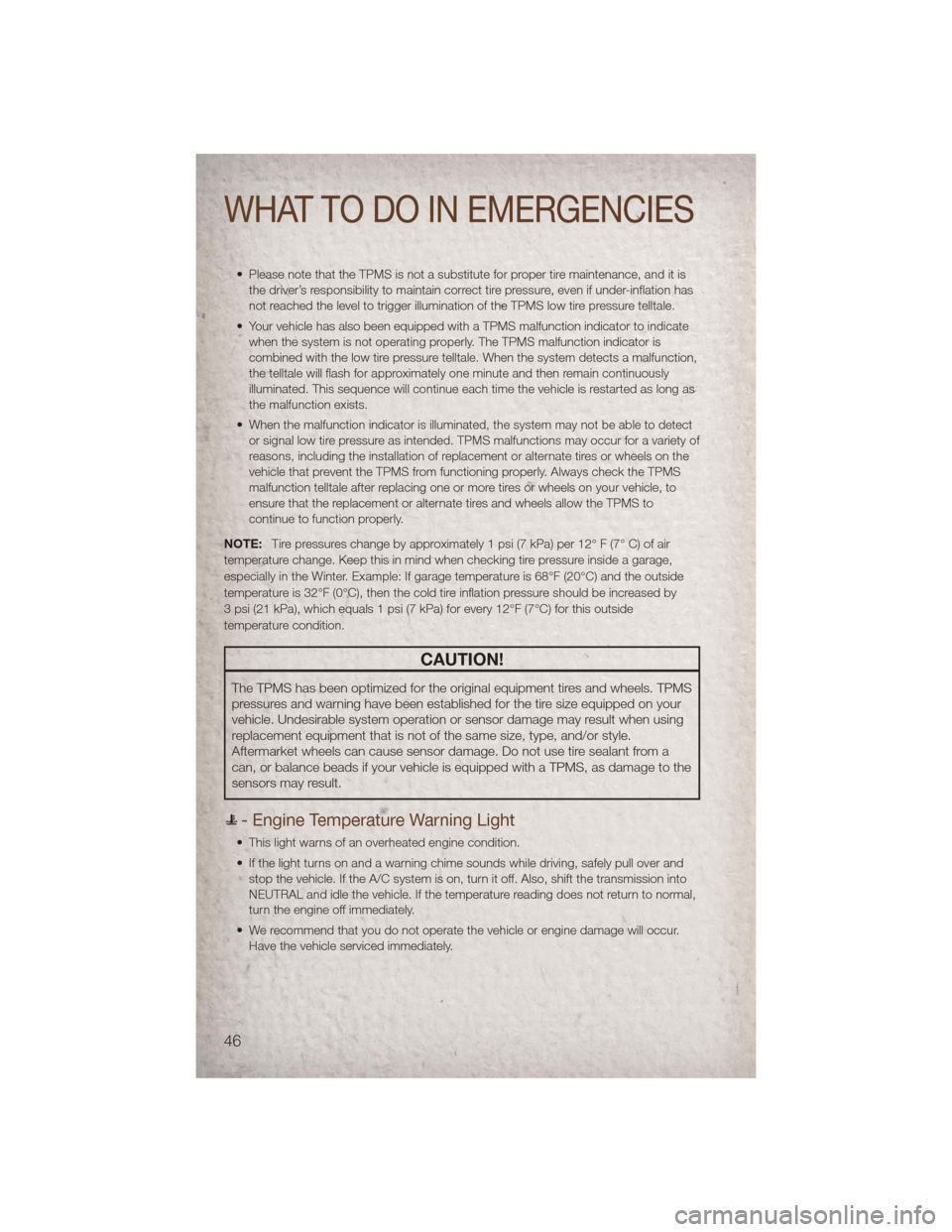
• Please note that the TPMS is not a substitute for proper tire maintenance, and it isthe driver’s responsibility to maintain correct tire pressure, even if under-inflation has
not reached the level to trigger illumination of the TPMS low tire pressure telltale.
• Your vehicle has also been equipped with a TPMS malfunction indicator to indicate when the system is not operating properly. The TPMS malfunction indicator is
combined with the low tire pressure telltale. When the system detects a malfunction,
the telltale will flash for approximately one minute and then remain continuously
illuminated. This sequence will continue each time the vehicle is restarted as long as
the malfunction exists.
• When the malfunction indicator is illuminated, the system may not be able to detect or signal low tire pressure as intended. TPMS malfunctions may occur for a variety of
reasons, including the installation of replacement or alternate tires or wheels on the
vehicle that prevent the TPMS from functioning properly. Always check the TPMS
malfunction telltale after replacing one or more tires or wheels on your vehicle, to
ensure that the replacement or alternate tires and wheels allow the TPMS to
continue to function properly.
NOTE: Tire pressures change by approximately 1 psi (7 kPa) per 12° F (7° C) of air
temperature change. Keep this in mind when checking tire pressure inside a garage,
especially in the Winter. Example: If garage temperature is 68°F (20°C) and the outside
temperature is 32°F (0°C), then the cold tire inflation pressure should be increased by
3 psi (21 kPa), which equals 1 psi (7 kPa) for every 12°F (7°C) for this outside
temperature condition.
CAUTION!
The TPMS has been optimized for the original equipment tires and wheels. TPMS
pressures and warning have been established for the tire size equipped on your
vehicle. Undesirable system operation or sensor damage may result when using
replacement equipment that is not of the same size, type, and/or style.
Aftermarket wheels can cause sensor damage. Do not use tire sealant from a
can, or balance beads if your vehicle is equipped with a TPMS, as damage to the
sensors may result.
- Engine Temperature Warning Light
• This light warns of an overheated engine condition.
• If the light turns on and a warning chime sounds while driving, safely pull over and stop the vehicle. If the A/C system is on, turn it off. Also, shift the transmission into
NEUTRAL and idle the vehicle. If the temperature reading does not return to normal,
turn the engine off immediately.
• We recommend that you do not operate the vehicle or engine damage will occur. Have the vehicle serviced immediately.
WHAT TO DO IN EMERGENCIES
46
Page 54 of 80
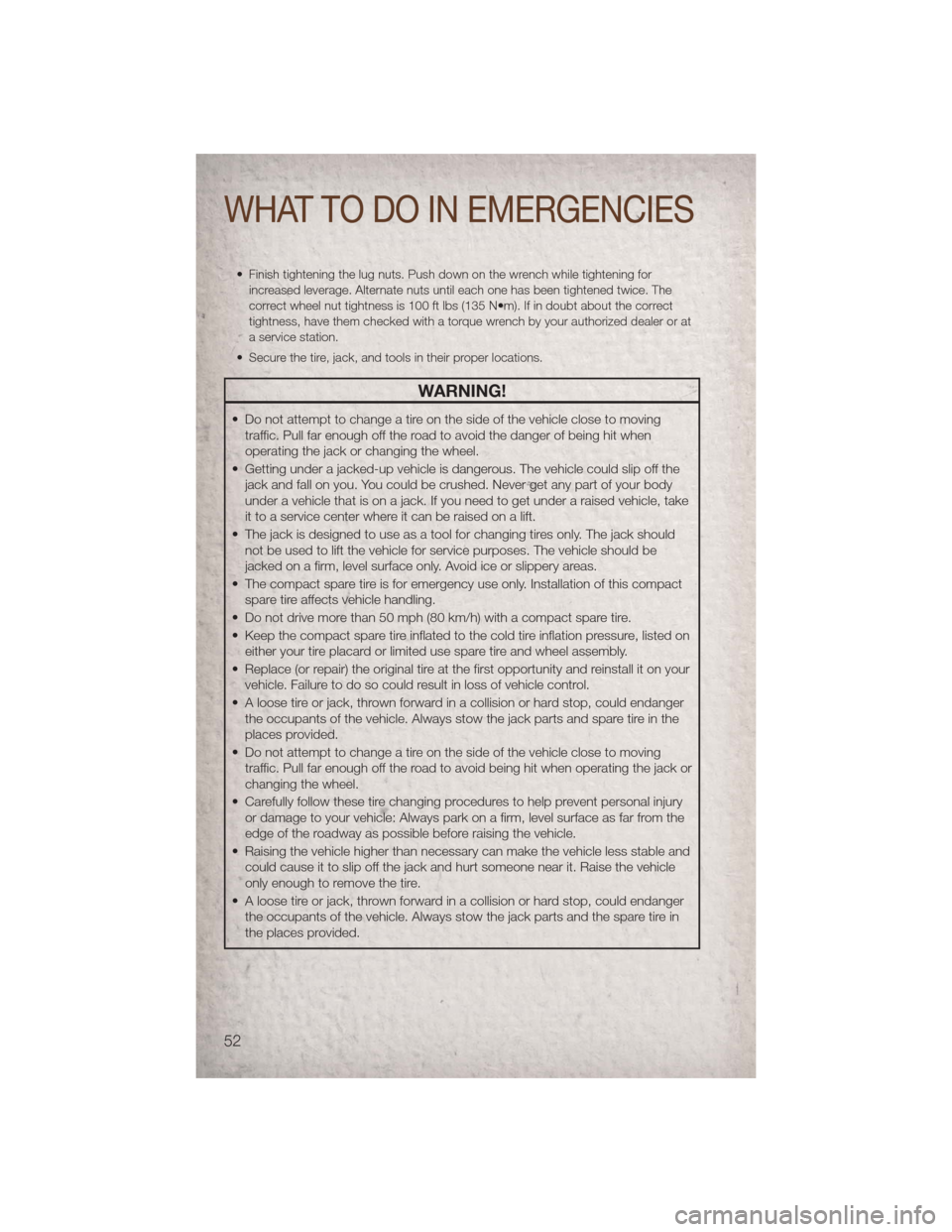
• Finish tightening the lug nuts. Push down on the wrench while tightening forincreased leverage. Alternate nuts until each one has been tightened twice. The
correct wheel nut tightness is 100 ft lbs (135 N•m). If in doubt about the correct
tightness, have them checked with a torque wrench by your authorized dealer or at
a service station.
• Secure the tire, jack, and tools in their proper locations.
WARNING!
• Do not attempt to change a tire on the side of the vehicle close to moving traffic. Pull far enough off the road to avoid the danger of being hit when
operating the jack or changing the wheel.
• Getting under a jacked-up vehicle is dangerous. The vehicle could slip off the jack and fall on you. You could be crushed. Never get any part of your body
under a vehicle that is on a jack. If you need to get under a raised vehicle, take
it to a service center where it can be raised on a lift.
• The jack is designed to use as a tool for changing tires only. The jack should not be used to lift the vehicle for service purposes. The vehicle should be
jacked on a firm, level surface only. Avoid ice or slippery areas.
• The compact spare tire is for emergency use only. Installation of this compact spare tire affects vehicle handling.
• Do not drive more than 50 mph (80 km/h) with a compact spare tire.
• Keep the compact spare tire inflated to the cold tire inflation pressure, listed on either your tire placard or limited use spare tire and wheel assembly.
• Replace (or repair) the original tire at the first opportunity and reinstall it on your vehicle. Failure to do so could result in loss of vehicle control.
• A loose tire or jack, thrown forward in a collision or hard stop, could endanger the occupants of the vehicle. Always stow the jack parts and spare tire in the
places provided.
• Do not attempt to change a tire on the side of the vehicle close to moving traffic. Pull far enough off the road to avoid being hit when operating the jack or
changing the wheel.
• Carefully follow these tire changing procedures to help prevent personal injury or damage to your vehicle: Always park on a firm, level surface as far from the
edge of the roadway as possible before raising the vehicle.
• Raising the vehicle higher than necessary can make the vehicle less stable and could cause it to slip off the jack and hurt someone near it. Raise the vehicle
only enough to remove the tire.
• A loose tire or jack, thrown forward in a collision or hard stop, could endanger the occupants of the vehicle. Always stow the jack parts and the spare tire in
the places provided.
WHAT TO DO IN EMERGENCIES
52
Page 66 of 80
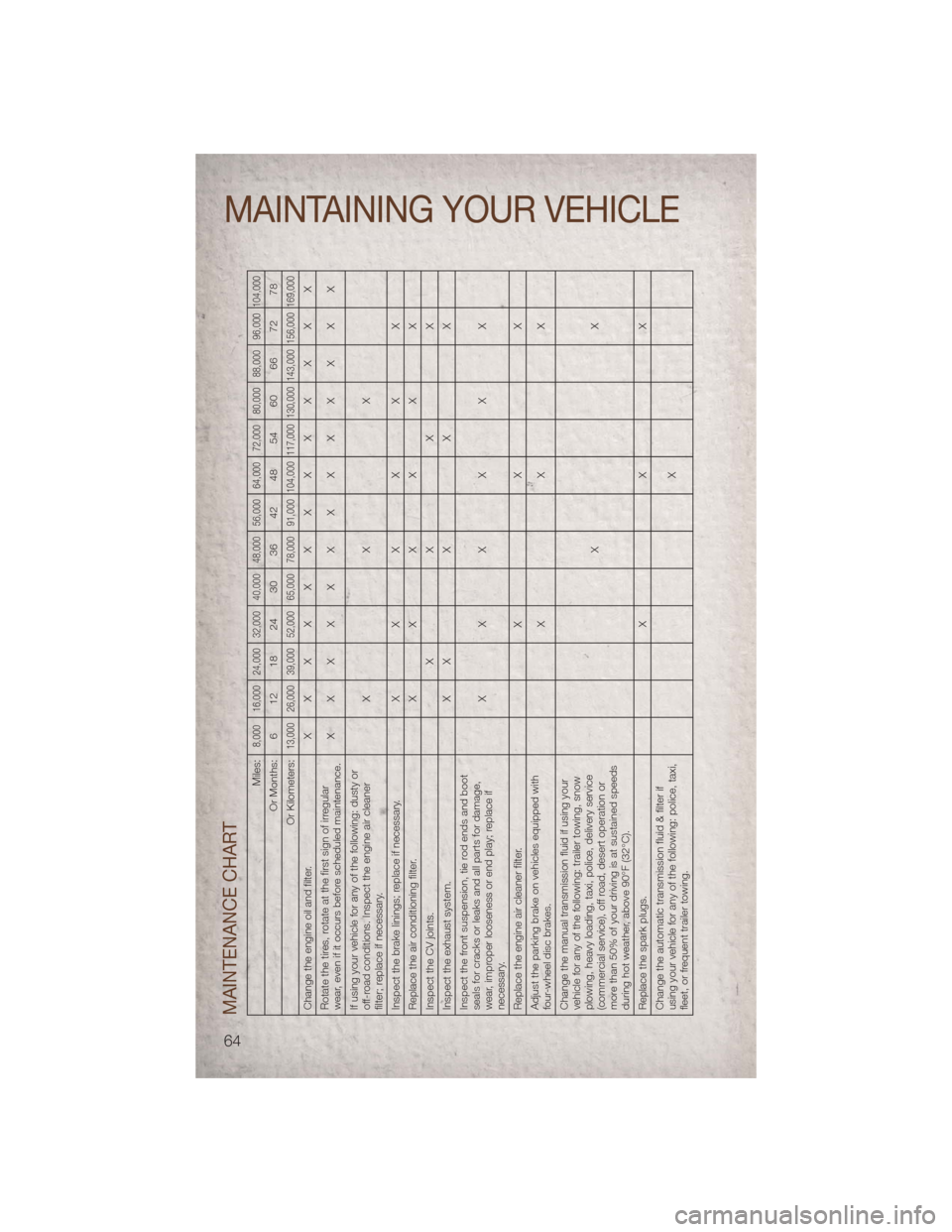
MAINTENANCE CHART
Miles:
8,000 16,000 24,000 32,000 40,000 48,000 56,000 64,000 72,000 80,000 88,000 96,000 104,000
Or Months: 6 12 18 24 30 36 42 48 54 60 66 72 78
Or Kilometers:
13,000 26,000 39,000 52,000 65,000 78,000 91,000 104,000 117,000 130,000 143,000 156,000 169,000
Change the engine oil and filter. XXXXXXXXXXXXX
Rotate the tires, rotate at the first sign of irregular
wear, even if it occurs before scheduled maintenance. XXXXXXXXXXXXX
If using your vehicle for any of the following: dusty or
off-road conditions. Inspect the engine air cleaner
filter; replace if necessary. XXX
Inspect the brake linings; replace if necessary. X X X X X X
Replace the air conditioning filter. X X X X X X
Inspect the CV joints. XXXX
Inspect the exhaust system. X XXXX
Inspect the front suspension, tie rod ends and boot
seals for cracks or leaks and all parts for damage,
wear, improper looseness or end play; replace if
necessary. XXXXXX
Replace the engine air cleaner filter. X X X
Adjust the parking brake on vehicles equipped with
four-wheel disc brakes. XXX
Change the manual transmission fluid if using your
vehicle for any of the following: trailer towing, snow
plowing, heavy loading, taxi, police, delivery service
(commercial service), off road, desert operation or
more than 50% of your driving is at sustained speeds
during hot weather, above 90°F (32°C). XX
Replace the spark plugs. XXX
Change the automatic transmission fluid & filter if
using your vehicle for any of the following: police, taxi,
fleet, or frequent trailer towing. X
MAINTAINING YOUR VEHICLE
64
Page 75 of 80
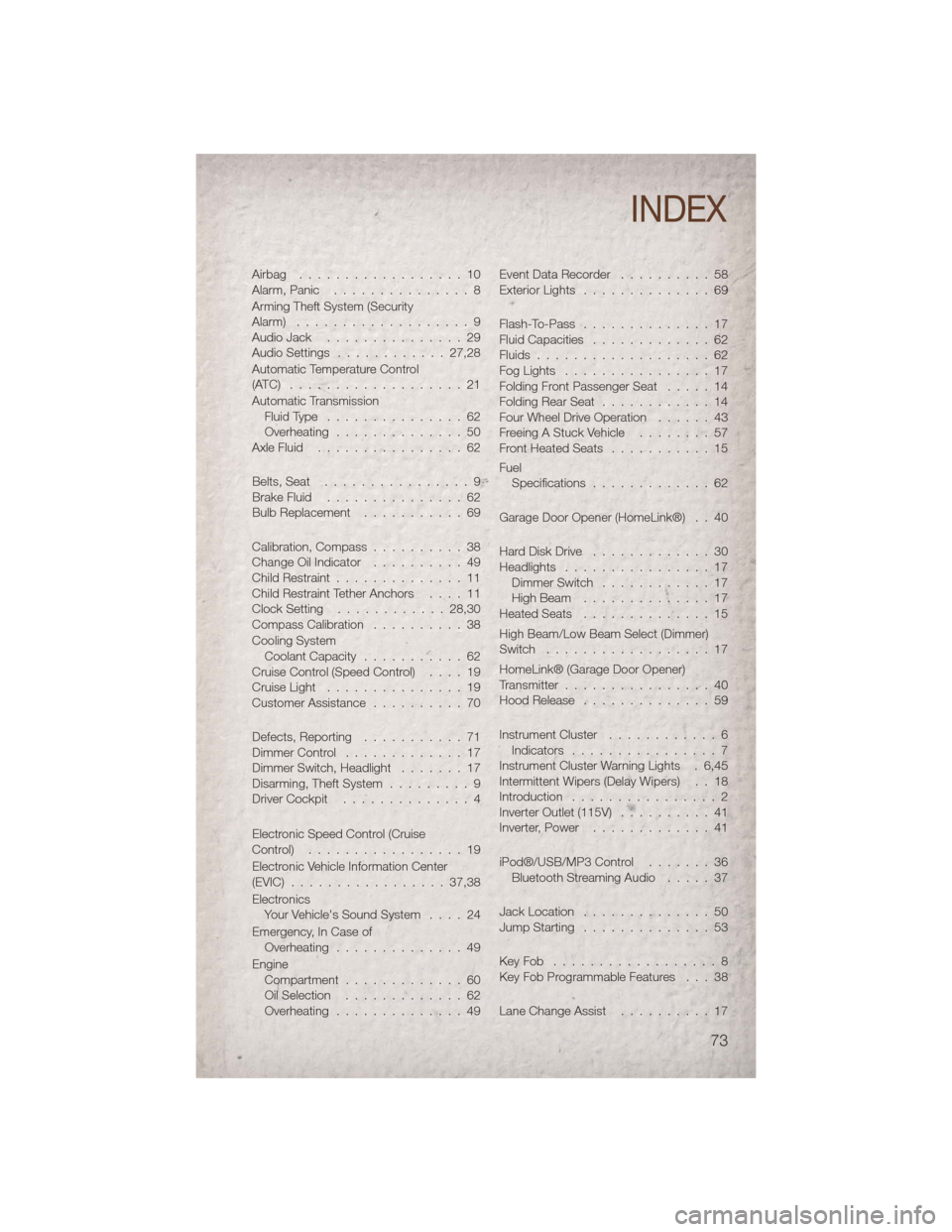
Airbag ..................10
Alarm,Panic ...............8
Arming Theft System (Security
Alarm) ...................9
Audio Jack...............29
Audio Settings ............27,28
Automatic Temperature Control
(ATC) ...................21
Automatic Transmission FluidType ...............62
Overheating ..............50
AxleFluid ................62
Belts, Seat ................9
BrakeFluid ...............62
Bulb Replacement ...........69
Calibration, Compass ..........38
Change Oil Indicator ..........49
Child Restraint ..............11
Child Restraint Tether Anchors ....11
Clock Setting ............28,30
Compass Calibration ..........38
Cooling System Coolant Capacity ...........62
Cruise Control (Speed Control) ....19
CruiseLight ...............19
Customer Assistance ..........70
Defects, Reporting ...........71
Dimmer Control .............17
Dimmer Switch, Headlight .......17
Disarming, Theft System .........9
Driver Cockpit ..............4
Electronic Speed Control (Cruise
Control) .................19
Electronic Vehicle Information Center
(EVIC) .................37,38
Electronics Your Vehicle's Sound System ....24
Emergency, In Case of Overheating ..............49
Engine Compartment .............60
OilSelection .............62
Overheating ..............49 Event Data Recorder
..........58
Exterior Lights ..............69
Flash-To-Pass ..............17
Fluid Capacities .............62
Fluids ...................62
FogLights ................17
Folding Front Passenger Seat .....14
Folding Rear Seat ............14
Four Wheel Drive Operation ......43
Freeing A Stuck Vehicle ........57
Front Heated Seats ...........15
Fuel Specifications .............62
Garage Door Opener (HomeLink®) . . 40
Hard Disk Drive .............30
Headlights ................17
Dimmer Switch ............17
High Beam ..............17
HeatedSeats ..............15
High Beam/Low Beam Select (Dimmer)
Switch ..................17
HomeLink® (Garage Door Opener)
Transmitter ................40
Hood Release ..............59
Instrument Cluster ............6
Indicators ................7
Instrument Cluster Warning Lights . 6,45
Intermittent Wipers (Delay Wipers) . . 18
Introduction ................2
Inverter Outlet (115V) ..........41
Inverter
, Power .............41
iPod®/USB/MP3 Control .......36
Bluetooth Streaming Audio .....37
Jack Location ..............50
Jump Starting ..............53
KeyFob ..................8
Key Fob Programmable Features . . . 38
Lane Change Assist ..........17
INDEX
73
Page 76 of 80
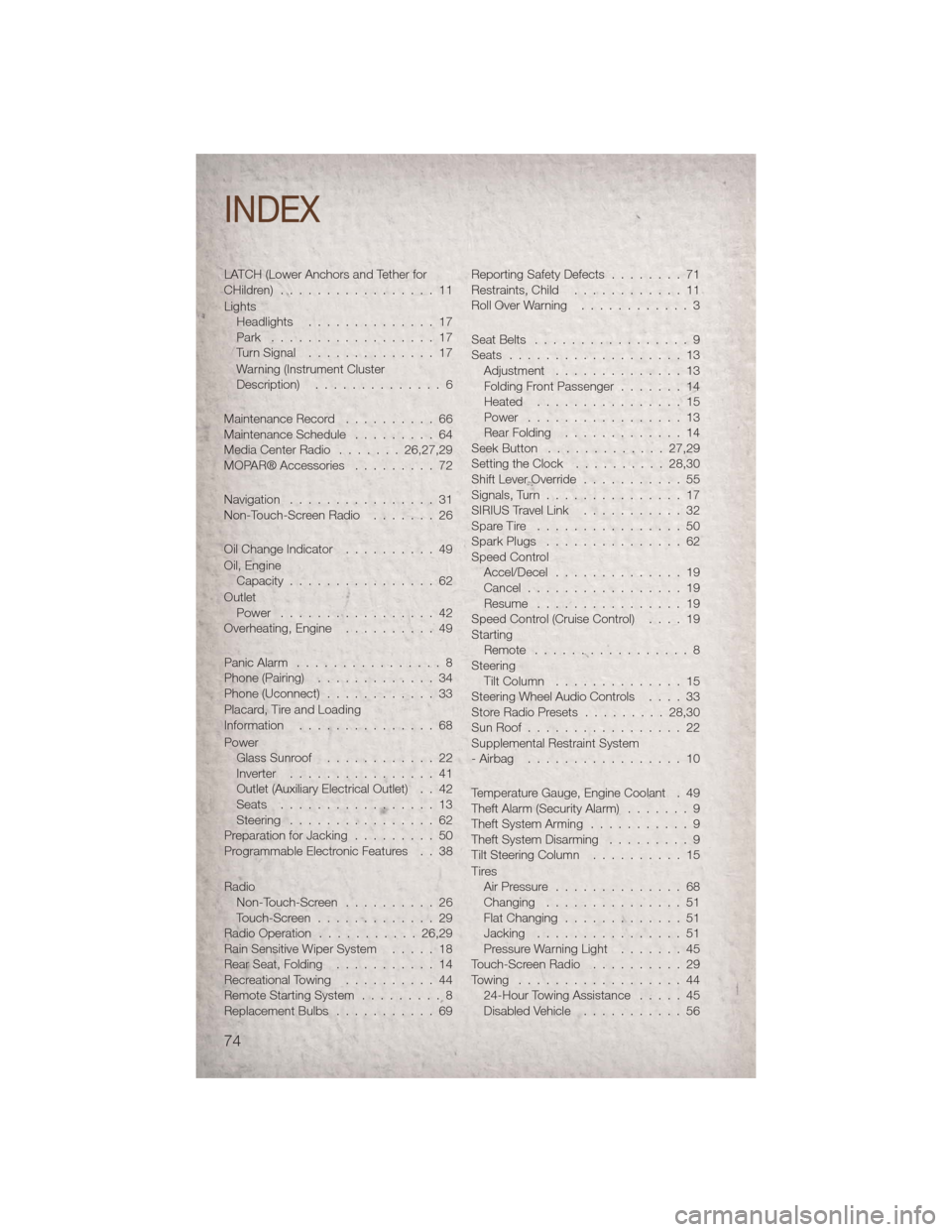
LATCH (Lower Anchors and Tether for
CHildren) .................11
LightsHeadlights ..............17
Park ..................17
TurnSignal ..............17
Warning (Instrument Cluster
Description) ..............6
Maintenance Record ..........66
Maintenance Schedule .........64
Media Center Radio .......26,27,29
MOPAR® Accessories .........72
Navigation ................31
Non-Touch-Screen Radio .......26
Oil Change Indicator ..........49
Oil, Engine Capacity ................62
Outlet Power .................42
Overheating, Engine ..........49
Panic Alarm ................8
Phone (Pairing) .............34
Phone (Uconnect) ............33
Placard, Tire and Loading
Information ...............68
Power Glass Sunroof ............22
Inverter ................41
Outlet (Auxiliary Electrical Outlet) . . 42
Seats .................13
Steering ................62
PreparationforJacking .........50
Programmable Electronic Features . . 38
Radio Non-Touch-Screen ..........26
Touch-Screen .............29
Radio Operation ...........26,29
Rain Sensitive Wiper System .....18
Rear Seat, Folding ...........14
Recreational Towing ..........44
Remote Starting System .........8
Replacement Bulbs ...........69 Reporting Safety Defects
........71
Restraints, Child ............11
RollOverWarning ............3
Seat Belts .................9
Seats ...................13
Adjustment ..............13
Folding Front Passenger .......14
Heated ................15
Power .................13
Rear Folding .............14
Seek Button .............27,29
Setting the Clock ..........28,30
Shift Lever Override ...........55
Signals,Turn...............17
SIRIUSTravelLink ...........32
Spare Tire ................50
Spark Plugs ...............62
Speed Control Accel/Decel ..............19
Cancel .................19
Resume ................19
Speed Control (Cruise Control) ....19
Starting Remote .................8
Steering T
ilt Column ..............15
Steering Wheel Audio Controls ....33
Store Radio Presets .........28,30
Sun Roof .................22
Supplemental Restraint System
-Airbag .................10
Temperature Gauge, Engine Coolant . 49
Theft Alarm (Security Alarm) .......9
Theft System Arming ...........9
Theft System Disarming .........9
Tilt Steering Column ..........15
Tires AirPressure ..............68
Changing ...............51
Flat Changing .............51
Jacking ................51
Pressure Warning Light .......45
Touch-Screen Radio ..........29
Towing ..................44 24-Hour Towing Assistance .....45
DisabledVehicle ...........56
INDEX
74